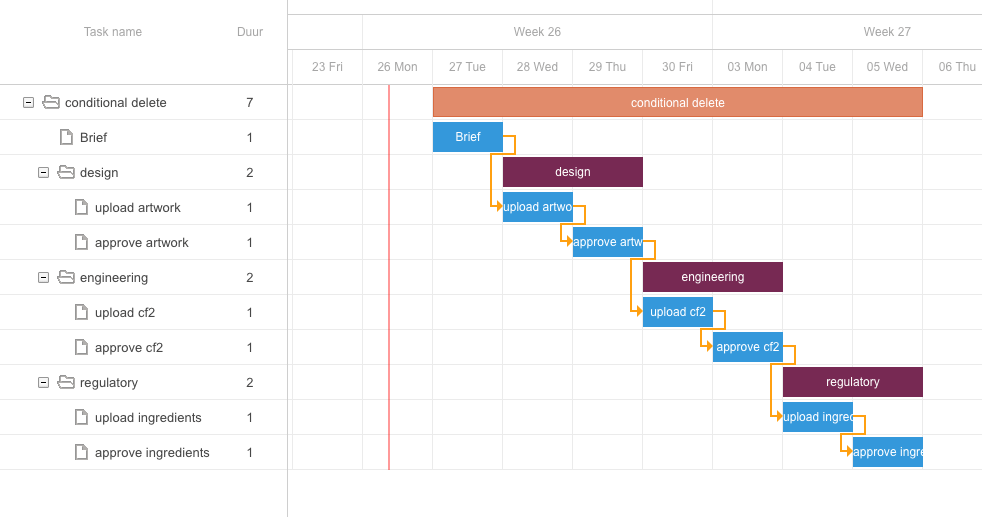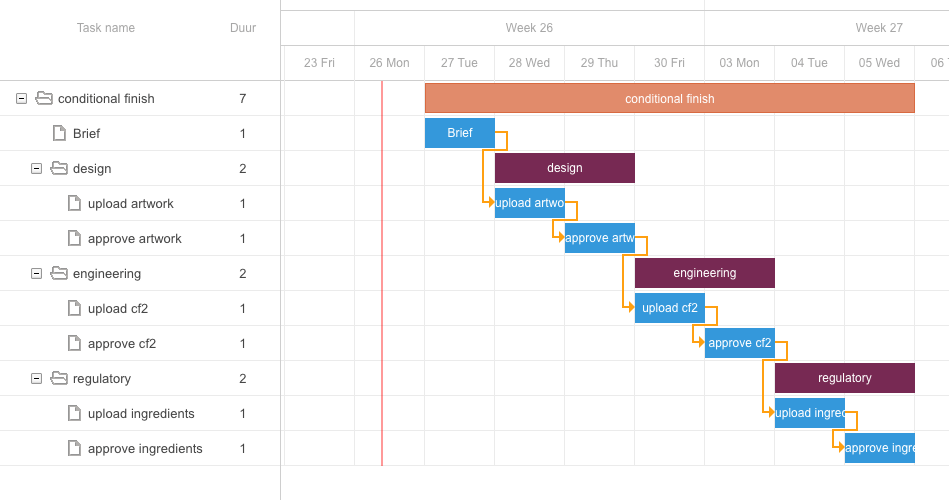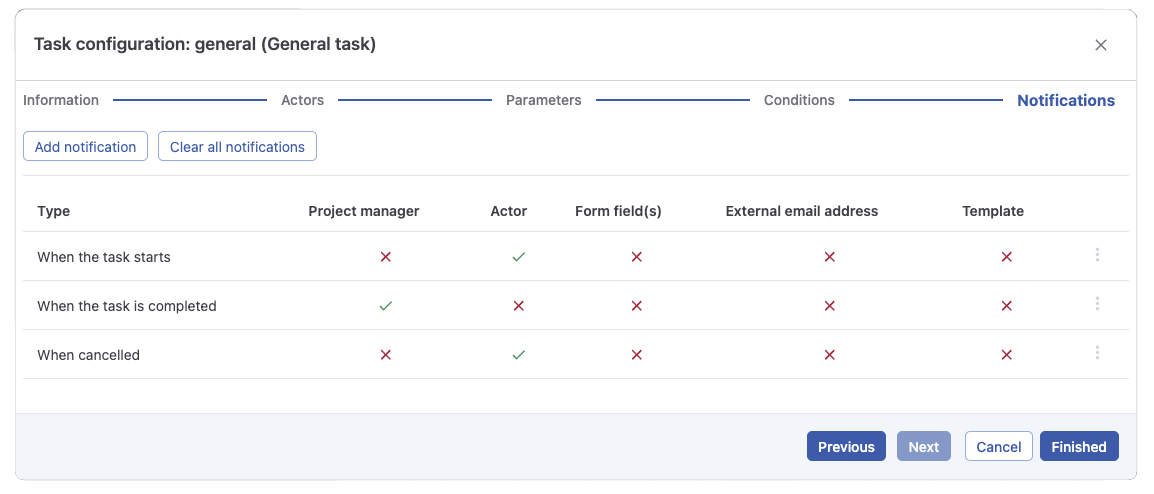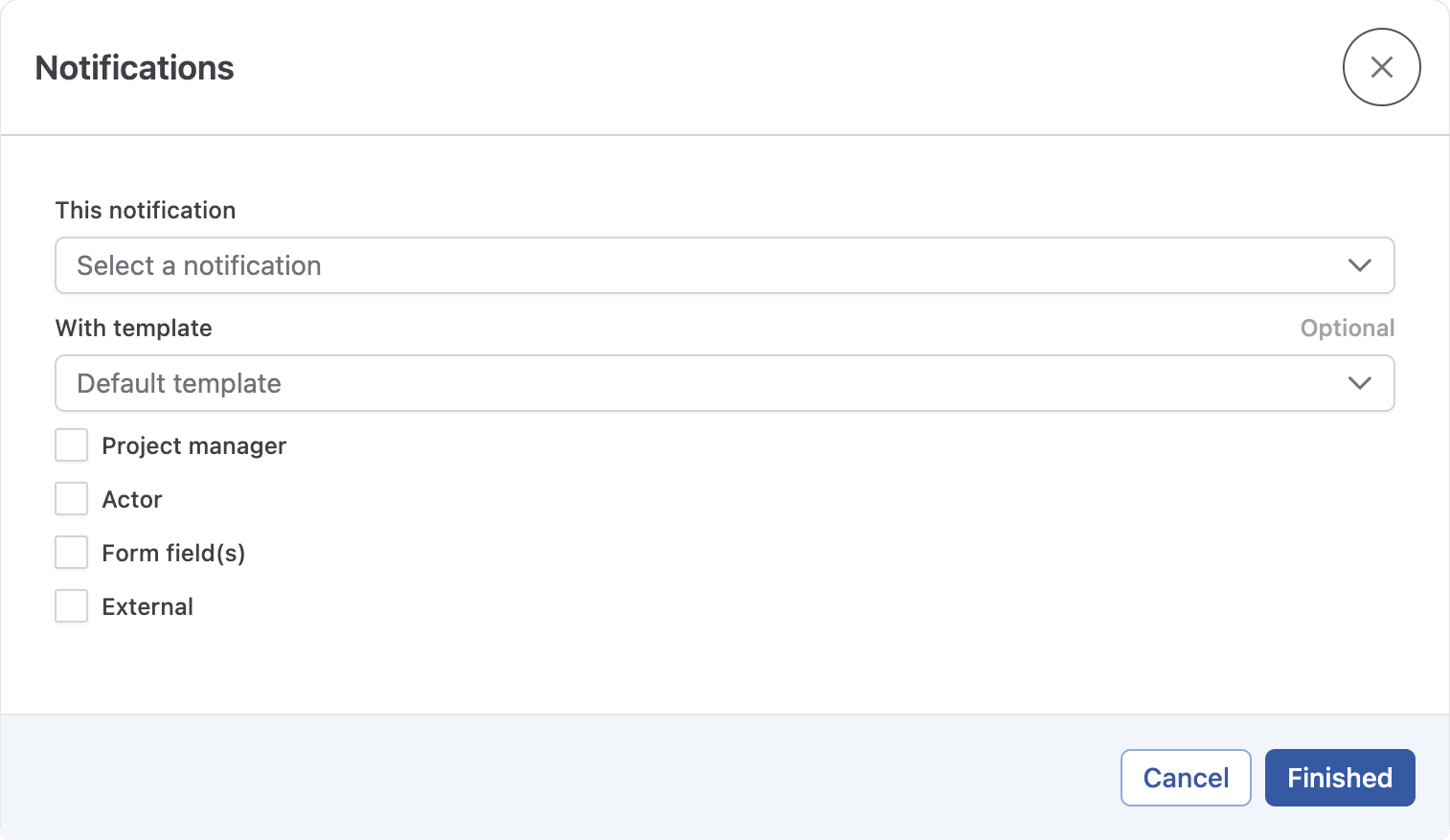Task
What is a task?
In projects, a task is a discrete unit of work that needs to be completed as part of a larger project. Tasks are typically assigned to specific actors or actor groups with a due date and any necessary dependencies or resources. They can be organized into groups or phases to help with prioritization and tracking progress. By breaking down larger projects into smaller tasks, project managers can ensure that work is evenly distributed and that deadlines are met.
A task is an entity that can be viewed from two different perspectives.
The project manager will see a task in the context of a project. Here it will be displayed in the tasks list or in the gantt chart view. In the gantt chart view, the project manager will be able to see the configuration of the task and edit it. Editing is possible as long as the task is still in the “To be started“ status.
An actor will see the same task in the “Tasks“ module. Upon clicking the task, a modal will be presented where the actor can complete the assignment at hand and choose to finish the task.
Configuring a task
To be able to properly configure a task, it is necessary to understand what this configuration includes. In this article we will go over the 5 main sections of the task configuration wizard and their contents.
All though the main sections are the same for all task types, some content might be different. This difference is mainly triggered by the task-type.
Information
Tasktype
The task-type indicates what the action performed by/during the task will be. A full list of all task-types and a breakdown of their functions can be found in Task Types.
The choice made in this parameter will determine the nature of the task and also the parameters found in this configuration wizard.
Taskname
The name used to identify the task.
This name will be visible in:
the gantt chart view of a project or template
the tasks view of a project or template
the tasks module, presented to an actor
Description
Description describes the task. Helps provide further explanation to an actor before performing the task.
The description will be visible in the task modal when the actor executes the task.
Startdate
The startdate decides the date when the task will become active.
If a task does not have any upstream tasks, a datepicker will be available to set a static date of start.
As with other measures of time in the project module, these should interpreted as durations, where the anchor is the start point of the entire project. All other timings will be based off of the project startdate.
If the task has upstream tasks, the startdate will be determined by the enddate of these preceding tasks.
Note that if you have multiple tasks connected, all upstream tasks need to be finished before the task starts.
The button “Previous tasks“ at the end of the startdate field, gives an overview of all of the upstream and not connected tasks in the current project. Downstream tasks are not mentioned in this list.
In this list, an indication of the upstream tasks is made with a blue check.
Startdate determined by previous tasks
Lists all of the upstream tasks that are immediately connected and thus determine the startdate. If a task is removed from this list, the connection is also broken.
The enddate of the last completed task in this list will equal the startdate of current task.
Enddate
The end can be determined either via the datepicker or by choosing a task duration. Both are connected to one another. Selecting an enddate in a weekend is not possible. After Friday follows Monday, while only increasing the duration with 1 day, Saturday and Sunday are not counted towards the duration.
Actors
a set of fixed actors
Display two adjacent lists: “Available actors“ and “Chosen actors“.
Selecting actors happens by picking actors from the “Available actors“ list and moving them to the “Chosen actors” list. This is done by clicking the arrow pointing in the direction of the desired list. Removing actors from this list happens with the same logic.
When selecting multiple actors in a task configuration, a task will be generated for every actor in their tasks module. Completion of the task will happen on a first come, first serve basis. The first person to finish the task, will finish it for the other actors involved as well. Completing the action described in the task does not automatically finish the task, which gives the other actors the opportunity to participate in the task as well.
based on a form element
Select an element from the metadata form in this project to populate the actor parameter with.
based on a database relationship
Select an existing database relation to populate the actor parameter with.
The source database in the relationship has to be present in the project metadata form.
For further information on creating database relationships, see: Database Relations and How-to: configure database relations
the project manager
The Project Manager is the person starting the project. This is an easy way to assign the initiator of the project as actor. In DOQMIND, the initiator of the project is regarded as the project manager of said project.
The task-types “Parallel approval“ and “Moving of files“ are automatic tasks and don’t use an actor. Filling in is required to finish the modal, but they are not used for execution.
Parameters
The parameters of a task are always specific to the task-type chosen in the information section. For a breakdown of the different task-types available in DOQMIND and their parameters, please see Task Types.
Conditions
The two actions that can be performed by conditions are to change the status the task to either Finish or Delete.

example: conditionally deleting the task group “engineering“

example: conditionally finishing the task group “engineering“
The condition that precedes this is built up of the following elements:
Form Element
Clicking “Choose“ produces a drop-down with all available forms. Only the form that is used as a project metadata form in this project is eligible for use in a condition. This means that only the form that was used as project metadata form here should be chosen.
Main operation
The operators that evaluate the content of the “Form Element” with the “Value”.
Equal to
Not equal to Higher than
Lower than
Contains
Does not contain
Value
The content of the form element to be evaluated.
Notifications
When configuring a task, a notification can be configured to alert stakeholders in the project.

the Notifications tab of a newly created task, showing the 3 default notifications.
By default, three notifications are present in a newly created task:
Alert the actor when the task starts
Alert the project manager when the task has been completed
Alert the actor when the task is cancelled
Any present notifications, including these 3 defaults, can easily be removed with the “Clear all notifications” button.
There are 3 elements that make up a notification:

This notification
Select at which point in time the notification is sent.
Day(s) after due date when not finished
Day(s) before deadline
Day(s) before start
When changing the actor
When the due date expires
When the task has been completed
When the task has been modified
When the task starts
day(s) after start when not opened
With template
Select the template used to compose the email. See Configure a mail template and Projectsfor more information on email templates
Notifies
Select who is being notified
Combinations can be made between the 4 available options.
When ‘from field(s)' is selected, you can select form fields marked as 'email fields (see Create a new form for details).
When “External“ is selected, the interface produces an entry field to provide an email address
